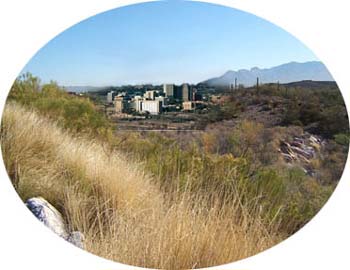
There's a long association between the name of St. Augustine and the Tucson area, dating back to the Spanish military and missionary presence in the 1700s.
There were two villages with the name of San Agustín del Tucson. The first was situated at the foot of today's A Mountain, and the second grew up around the Spanish Presidio (fort) of Tucson which was located across the Santa Cruz River from the first. Churches under the patronage of St. Augustine were built at both sites, but only the church at the Presidio lasted into the American territorial period.
In the mid 1800s, a third church of St. Augustine was built. A historical marker in a small park at Church and Broadway downtown marks the location of that adobe and stone structure, whose arched portal now decorates the entrance to the Arizona Historical Society Museum at 949 East 2nd Street in Tucson. This church, used by Arizona's first bishop, Jean Baptiste Salpointe of France, was abandoned after a new church of St. Augustine was built in 1897 and dedicated by Bishop Peter Bourgade, also of France, on the site of today's Cathedral.
The original plans for the new church called for a Gothic style structure with thin pointed spires, but because of lack of funds the spires were never completed. So, for more than thirty years, including those of a third French bishop, Henry Granjon, Tucson's Catholics worshipped in a church of bare brick walls that had only the bases of towers. It was Bishop Daniel Gercke, the first U.S. born bishop of Tucson, who began the transformation of that brick structure into the outstanding example of Mexican baroque architecture you see today, including the magnificent cast stone facade completed in 1928 which was inspired by the Cathedral of Querétaro, Mexico.
With the exception of the facade and towers, the Cathedral was demolished and rebuilt in the late 1960s under the leadership of Bishop Francis J. Green.
